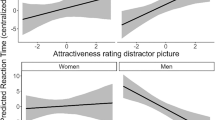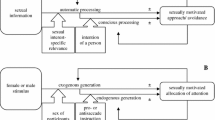Abstract
Sexually attractive stimuli are watched longer than unattractive stimuli. The processes underlying this robust and reliable viewing time effect are presently not well understood. In the present research comprising four experiments (total N = 250), four classes of potential explanations are proposed and the derived implications were experimentally tested. Contrary to explanations based on either deliberate delay or attentional adhesion to sexually attractive stimuli, prolonged response latencies were also found under restricted task conditions. Sexually preferred targets elicited longer response latencies in a self-paced evaluation task when stimulus pictures were presented for 750 ms (Experiment 1) or for 500 ms and followed by a pattern mask (Experiment 2). Prolonged latencies for sexually preferred targets were also observed when sexual attractiveness was rated in a speeded binary decision task with a response window of 1000 ms (Experiment 3). Eventually, it was shown that the response latency effect in the speeded binary choice task was still preserved when only the heads of target individuals were presented instead of the bodies (Experiment 4). Mate identification and schematic processes are discussed as the remaining plausible mechanisms for prolonged response latencies for sexually attractive targets under restricted conditions.




Similar content being viewed by others
References
Abel, G. G., Huffman, J., Warberg, B., & Holland, C. L. (1998). Visual reaction time and plethysmography as measures of sexual interest in child molesters. Sexual Abuse: A Journal of Research and Treatment, 10, 81–95.
Abel, G. G., Jordan, A., Hand, C. G., Holland, L. A., & Phipps, A. (2001). Classification models of child molesters utilizing the Abel Assessment for Sexual Interest™. Child Abuse and Neglect, 25, 703–718.
Banse, R., Schmidt, A. F., & Clabour, J. (2010). Indirect measures of sexual interest in child sex offenders: A multi-method approach. Criminal Justice and Behavior, 37, 319–335.
Brown, M., Amoroso, D. M., Ware, E. E., Pruesse, M., & Pilkey, D. W. (1973). Factors affecting viewing time of pornography. Journal of Social Psychology, 90, 125–135.
Chivers, M. L., Rieger, G., Latty, E., & Bailey, J. M. (2004). A sex difference in the specificity of sexual arousal. Psychological Science, 15, 736–744.
Chivers, M. L., Seto, M. C., & Blanchard, R. (2007). Gender and sexual orientation differences in sexual response to sexual activities versus gender of actors in sexual films. Journal of Personality and Social Psychology, 93, 1108–1121.
Epstein, S. (1990). Cognitive-experiential self-theory. In L. A. Pervin (Ed.), Handbook of personality theory and research (pp. 165–192). New York: Guilford.
Flak, V., Beech, A., & Fisher, D. (2007). Forensic assessment of deviant sexual interests: The current position. Issues in Forensic Psychology, 6, 70–83.
Freund, K. (1963). A laboratory method of diagnosing predominance of homo- and hetero-erotic interest in the male. Behaviour Research and Therapy, 1, 85–93.
Geer, J. H., & Bellard, H. S. (1996). Sexual content induced delays in unprimed lexical decisions: Gender and context effects. Archives of Sexual Behavior, 25, 91–107.
Geer, J. H., & Melton, J. S. (1997). Sexual content induced delay with double-entendre words. Archives of Sexual Behavior, 26, 295–316.
Gray, N. S., Brown, A. S., MacCulloch, M. J., Smith, J., & Snowden, R. J. (2005). An implicit test of the associations between children and sex in pedophiles. Journal of Abnormal Psychology, 114, 304–308.
Gress, L. Z. C. (2005). Viewing time and sexual interest: Another piece in the puzzle. Journal of Sexual Aggression, 11, 117–125.
Harris, G. T., Rice, M. E., Quinsey, V. L., & Chaplin, T. C. (1996). Viewing time as a measure of sexual interest among child molesters and heterosexual men. Behaviour Research and Therapy, 34, 389–394.
Imhoff, R., Schmidt, A. F., Bernhardt, J., Dierksmeier, A., & Banse, R. (2010). An inkblot for male sexual preference: A semantic variant of the affect misattribution procedure. Manuscript submitted for publication.
Ishai, A. (2007). Sex, beauty and the orbifrontal cortex. International Journal of Psychophysiology, 63, 181–185.
Israel, E., & Strassberg, D. S. (2009). Viewing time as an objective measure of sexual interest in heterosexual men and women. Archives of Sexual Behavior, 38, 551–558.
Kalmus, E., & Beech, A. R. (2005). Forensic assessments of sexual interest: A review. Aggression and Violent Behavior, 10, 193–217.
Karama, S., Lecours, A. R., Leroux, J.-M., Bourgoin, P., Beaudoin, G., Joubert, S., et al. (2002). Areas of brain activation in males and females during viewing of erotic film excerpts. Human Brain Mapping, 16, 1–13.
Konopansky, R. J., & Konopansky, A. W. B. (2000). Remaking penile plethysmography. In D. R. Laws, S. M. Hudson, & T. Ward (Eds.), Remaking relapse prevention with sex offenders (pp. 257–284). Thousand Oaks, CA: Sage.
Laws, D. R., & Gress, L. Z. C. (2004). Seeing things differently: The viewing time alternative to penile plethysmography. Legal and Criminological Psychology, 9, 183–196.
Love, R. E., Sloan, L. R., & Schmidt, M. J. (1976). Viewing pornography and sex guilt: the priggish, the prudent, and the profligate. Journal of Consulting and Clinical Psychology, 76, 624–629.
Maner, J. K., Gailliot, M. T., Rouby, D. A., & Miller, S. L. (2007). Can’t take my eyes off you: Attentional adhesion to mates and rivals. Journal of Personality and Social Psychology, 93, 389–401.
Mouras, H., Stoléru, S., Bittoun, J., Glutron, D., Pélégrini-Issac, M., Paradis, A.-L., et al. (2003). Brain processing of visual sexual stimuli in healthy men: A functional magnetic resonance imagining study. NeuroImage, 20, 855–869.
Pacific Psychological Assessment Corporation (PPAC). (2004). The NRP (Not Real People) stimulus set for assessment of sexual interest. Victoria, BC: Author.
Ponseti, J., Bosinski, H. A., Wolff, S., Peller, M., Jansen, O., Mehdorn, H. M., et al. (2006). A functional endophenotype for sexual orientation in humans. NeuroImage, 23, 825–833.
Quinsey, V., Ketsetzis, M., Earls, C., & Karamanouikan, A. (1996). Viewing time as a measure of sexual interest. Ethology and Sociobiology, 17, 341–354.
Redouté, J., Stoléru, S., Grégoire, M.-C., Costes, N., Cinotti, L., Lavenne, F., et al. (2000). Brain processing of visual sexual stimuli in human males. Human Brain Mapping, 11, 162–177.
Rosenzweig, S. (1942). The photoscope as an objective device for evaluating sexual interest. Psychosomatic Medicine, 4, 150–157.
Rupp, H. A., & Wallen, K. (2008). Sex differences in response to visual sexual stimuli: A review. Archives of Sexual Behavior, 37, 206–218.
Sachsenmaier, S. J., & Gress, C. L. Z. (2009). The Abel Assessment for Sexual Interests-2: A critical review. In D. Thornton & D. R. Laws (Eds.), Cognitive approaches to the assessment of sexual interest in sexual offenders (pp. 31–57). Chichester, UK: Wiley.
Safron, A., Barch, B., Bailey, J. M., Gitelman, D. R., Parrish, T. B., & Reber, P. J. (2007). Neural correlates of sexual arousal in homosexual and heterosexual men. Behavioral Neuroscience, 121, 237–248.
Santtila, P., Mokros, A., Viljanen, K., Koivisto, M., Sandnabba, N. K., & Osterheider, M. (2009). Assessment of sexual interest using a choice reaction time task and priming: A feasibility study. Legal and Criminological Psychology, 14, 65–82.
Singer, B. (1984). Conceptualizing sexual arousal and attraction. Journal of Sex Research, 20, 230–240.
Spiering, M., Everaerd, W., & Elzinga, B. (2002). Conscious processing of sexual information: Interference caused by sexual primes. Archives of Sexual Behavior, 31, 159–164.
Spiering, M., Everaerd, W., & Laan, E. (2004). Conscious processing of sexual information: Mechanisms of appraisal. Archives of Sexual Behavior, 33, 369–380.
Stoléru, S., Grégoire, M.-C., Gérard, D., Decety, J., Lafarge, E., Cinotti, L., et al. (1999). Neuroanatomical correlates of visually evoked sexual arousal in human males. Archives of Sexual Behavior, 28, 1–21.
Tanner, J. (1978). Foetus into man: Physical growth from conception to maturity. Cambridge, MA: Harvard University Press.
Ware, E. E., Brown, M., Amoroso, D. M., Pilkey, D. W., & Pruesse, M. (1972). The semantic meaning of pornographic stimuli for college males. Canadian Journal of Behavioural Science, 4, 204–209.
Wiegel, M., Scepkowski, L. A., & Barlow, D. H. (2007). Cognitive-affective processes in sexual arousal and sexual dysfunction. In E. Janssen (Ed.), The psychophysiology of sex (pp. 143–165). Bloomington, IN: Indiana University Press.
Wright, L., & Adams, H. (1994). Assessment of sexual preference using choice reaction time task. Journal of Psychopathology and Behavioral Assessment, 16, 221–231.
Zamansky, H. S. (1956). A technique for measuring homosexual tendencies. Journal of Personality, 24, 436–448.
Author information
Authors and Affiliations
Corresponding author
Rights and permissions
About this article
Cite this article
Imhoff, R., Schmidt, A.F., Nordsiek, U. et al. Viewing Time Effects Revisited: Prolonged Response Latencies for Sexually Attractive Targets Under Restricted Task Conditions. Arch Sex Behav 39, 1275–1288 (2010). https://doi.org/10.1007/s10508-009-9595-2
Received:
Revised:
Accepted:
Published:
Issue Date:
DOI: https://doi.org/10.1007/s10508-009-9595-2




